Corn Hybrid Selection
Originally written February 1, 2006 | Last updated
February 23, 2014
Kinds of Corn
Hybrids and varieties differ primarily in kernel starch.
Specialty Corns
- Marketing niche hybrids - Amylomaize (high amylose), waxy, high-protein (lysine),
high-oil, White and yellow food, high available phosphorus, silage, sweetcorn, and
popcorn
- Management tool hybrids - imidazolinone (IT/IR), Bt-CB, Bt-CR, glyphosate
resistant (RR), glufosinate resistant(LL), sethoxydim resistant (SR), "stacks"
|
DENT
- 2/3 of starch is hard and 1/3 is soft
- Dent caused by shrinkage of soft starch in crown as kernel dries. Surrounding hard
starch shrinks less
- 95%+ of US corn is dent corn
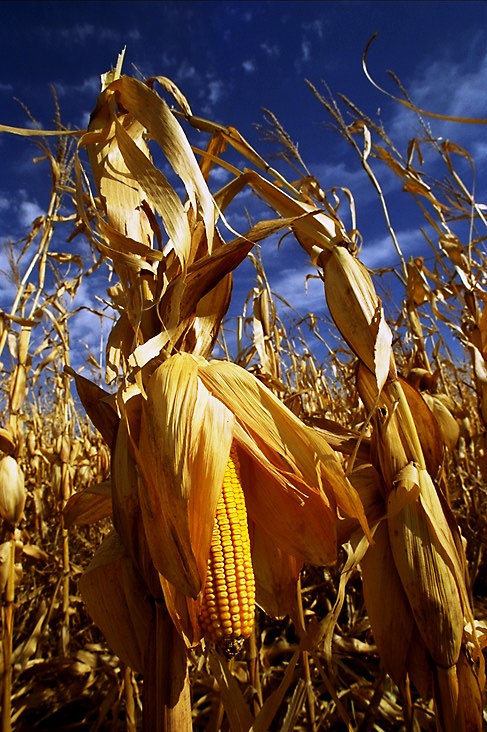


SWEET CORN
- Endosperm contains water soluble reducing sugar instead of starch
- Plants are leafy and tend to tiller
- Leading states are WI, MN, and IL

FLINT
- Very hard kernels, entire crown is hard starch
- Grown where season is too short for dents
- Kernels resist insect damage, but may be difficult for animals to digest

FLOUR
- Starch is soft and easily ground into meal
- Surrounded by thin layer of hard starch
- Widely grown by American Indians
POP
- Closely related to flint, but higher % of hard starch in pop corn
- Moisture in each starch grain expands with heating
- Good popper expands to 24X or more of its original volume
- Popcorn Institute; 401 N. Michigan; Chicago, IL 60611-4267 (312) 644-6610

POD
- Each kernel is surrounded by husks
- No economic importance
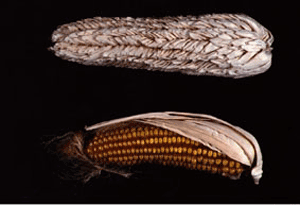
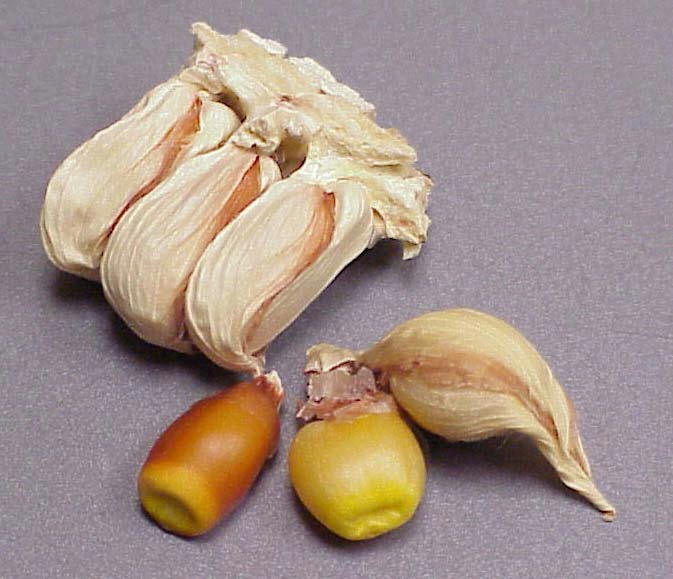
HIGH-OIL
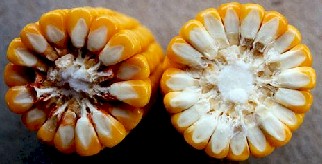
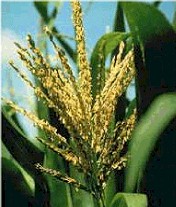
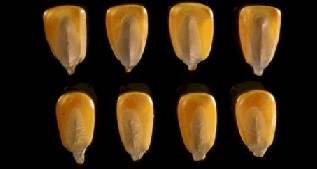
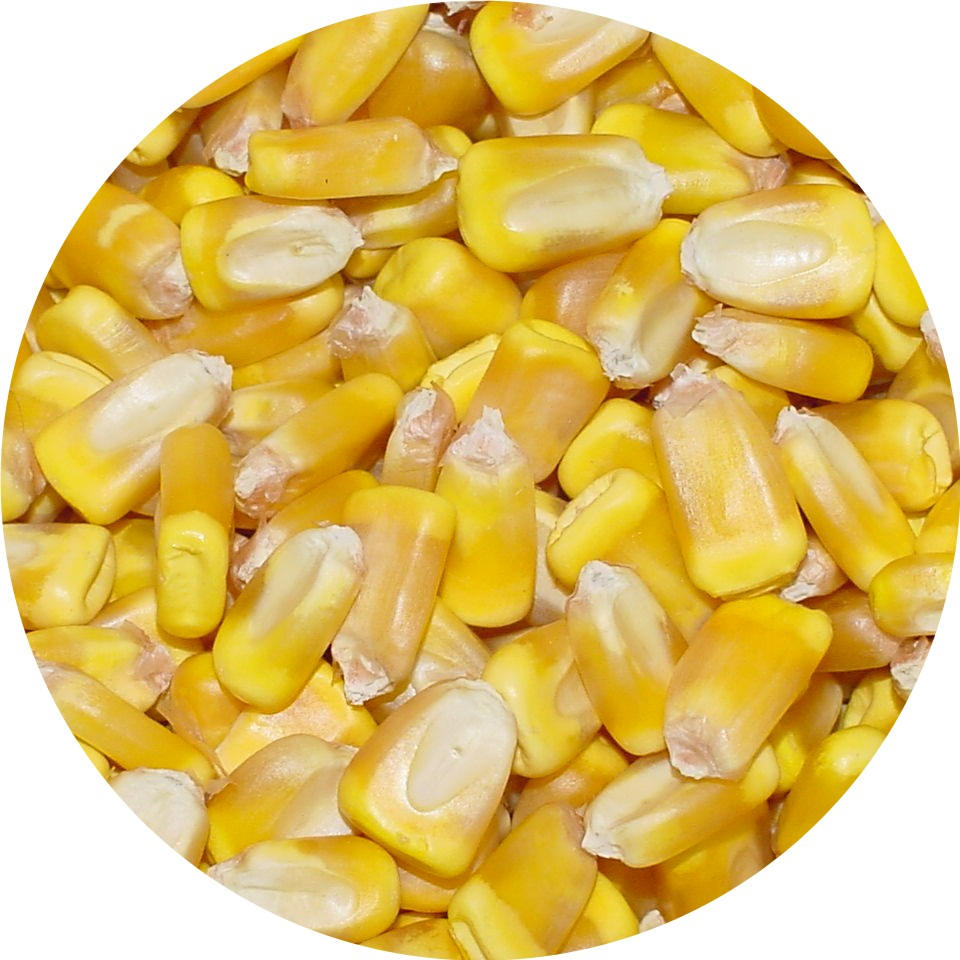
- Larger germ than normal corn
- 2x more oil content
WAXY
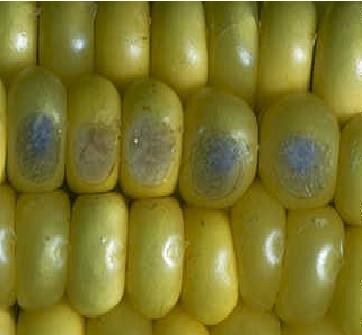

- Special kind of starch with a waxy (shiny) appearance
- Normal corn starch: 72% amylopectin (branched chain), 28% amylose (straight chain)
- Waxy starch: 100% amylopectin
- Introduced from China more than 90 yrs ago by an observant Presbyterian minister
in Shanghai who noted its unusual endosperm
- Endosperm stains light red (Normal endosperm = dark blue)
- Slight improvement over dents in feeding value for fattening cattle
- Increased in popularity in US after SCLB epidemic in 1970
- No difference between dent and waxy corn in yield
- Used in food products (pie thickener and tapioca pudding) and industrially (glue
for stamps and envelopes)
Selection Criteria
Important traits and characteristics that a variety or hybrid must have before it
can be grown on-farm.
Example: For corn use a Performance Index = PI
- Yield potential: PI = 50 %
- Maturity (moisture): PI = 35 %
- Standability: PI = 15 %
- Quality
- Other factors
| Criteria for Grain Hybrids |
Criteria for Silage Hybrids |
| Grain yield |
Forage yield |
| Grain moisture |
Forage quality (i.e. Starch content, NDFD, and NDF) |
| Plant lodging |
Disease and Insect resistance |
| Disease and Insect resistance |
Plant lodging |
| Grain quality (i.e. Test weight, kernel breakage susceptibility) |
Forage moisture |
| Other factors |
Other factors |
Yield potential and performance consistency
PI = 50 %
- Information sources
- Top performances - What is your yield potential?
- Importance of using multi-location averages and PI
Maturity (moisture)
PI = 35 %
Full season hybrid or variety: A hybrid or variety that uses (or requires) the entire
available growing season to reach physiological maturity before killing frost or
cool temperatures end the growing season.
Often has better yield potential than a shorter-season hybrid.
Full-season maturity depends upon:
- Growing season temperature GDD
- Soil type / texture / topography
- Tillage system
- Previous crop
- Planting date
Percentage of farm in various maturities depends upon:
- When you start planting
- How fast you plant
- Acres to plant
- Days available / needed for spring fieldwork before planting
- Drying costs
- How fast you harvest, haul and dry
- Days available / needed for fall fieldwork after harvest
- Corn silage / high moisture grain acres
- Your desire to take risks. Example: Suggested maturity ratios - conservative vs.
risky
- 50 % full-season (plant first)
- 30 % mid-season
- 20 % short-season
Relative maturity switch dates
- Plant Full-season hybrids until May 10
- Plant Mid-season hybrids from May 10 to May 25
- Plant Short-season hybrids after May 25 to June 10
- Switch to another crop after June 10
Standability
PI = 15 %
High amounts of lodging will slow harvest and decrease yields.
Caused by:
- Disease
- Insects
- High winds
Hybrid's ability to develop a root system
Pest resistance
No hybrid or variety is resistant to all pests
Check with seed dealer about: stalk rot, rust, northern leaf spot, smut, Gibberella
ear rot
Ear and Kernel Qualities
Quality factors
Test weight, protein, etc.
Other factors
- Type of cross: greater yield potential with single crosses
- Seed size and quality
- Hybrid response to management - i.e. soil type, plant population, conservation tillage,
soil fertility, herbicides, crop rotation, and irrigation
- Specialty uses
- "Yield lag" v. "yield drag"
Selecting the Top Performers
What data should you use?
- Information sources
- Seed company
- Unbiased (university) performance trials
- Local on-farm trials using field-scale equipment
- Top performances - What is your yield potential?
- Strategies for selecting hybrids in the UW trials
- Importance of using multi-location averages and PI
Conclusion: Use multi-location, average data (wide range of locations and climates)
for selecting the top performers
Steps in the hybrid selection process:
- Begin with trials in zones nearest your farm
- Compare hybrids with similar maturities within a trial
- Evaluate consistency of performance across zones & years
- Compare performance in other unbiased trials
- Consider hybrid performance for other traits, i.e. standability, dry-down rate,
grain quality, etc.
- You are taking a tremendous gamble if basing your decision on one or two local test
plots.
Summary
- Multi-Location information should be used to evaluate:
- Grain yield
- Moisture and maturity
- Standability
- Single-Location information should be used to evaluate:
- Consistency of performance
- Test weight
- Dry-down rate
- Grain quality
- Ease of combine-shelling or picking
The Wisconsin Corn Evaluation Program
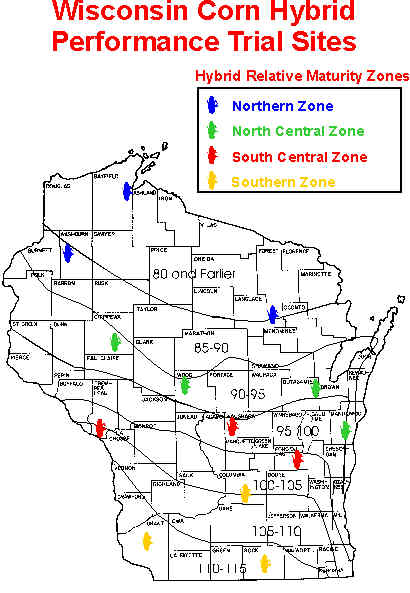
The University of Wisconsin Corn Hybrid Trials -- Selecting
the Top Performers
The Wisconsin Grain Relative Maturity (GRM) System for Corn
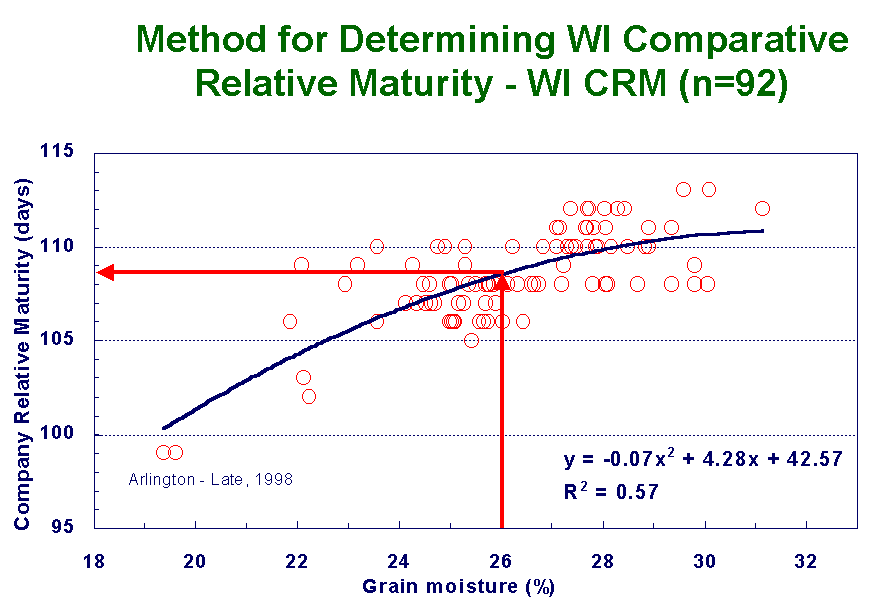
Corn Silage
Background
- Importance of Corn Silage to Wisconsin
- Largest acreage and production among U.S. States
- Used extensively in forage base for state dairy herds
- Changing Wisconsin dairy production ‘climate'
- Wisconsin Corn Silage Consortium (Coors et al.)
- Range for NDF and digestibility among commercial hybrids sold in Wisconsin is narrow.
- Yield and quality differences among corn hybrids are repeatable.
- Corn silage quality
can be predicted using NIR
Corn Silage Compared to Other Forages
Advantages
- Palatable forage
- High dry matter yield and energy content
- Consistent quality
- Less labor and machinery (one harvest). Lower cost per ton of dry matter
- Manure management
- Flexibility, dual purpose
Disadvantages
- Few established markets
- Relatively low in protein
- High transportation costs
- Must be fed on or near farm
- Expensive storage facilities
- Limited production on erodible soils due to conservation requirements
What makes a good forage? (Carter et al., 1991)
- High yield
- High energy (high digestibility)
- High intake potential (low fiber)
- High protein
- Proper moisture at harvest for storage
- Ultimate test is animal performance
- Milk2000 is our best predictor for performance (Schwab - Shaver equation)
Hybrid Selection
Criteria for Selecting Silage Hybrids
- Grain yield: allows flexibility (dual purpose)
- Whole plant silage yield
- Relative maturity: 5-10 days later than grain hybrids
- Standability: allows flexibility
- Pest resistance
- Silage quality
"Variation for silage yield and quality exists among commercial hybrids in Wisconsin."
"Dual Purpose" Hybrids versus Silage Specific
Other silage Hybrids
- High sugar
- Waxy
- High-oil
- Leafy Corn
- Bmr Corn
- Tropical
- Sweet corn
Further Reading
Selecting Corn Hybrids UWEX Bulletin A3265
Which Insect Traits Do
You Need?